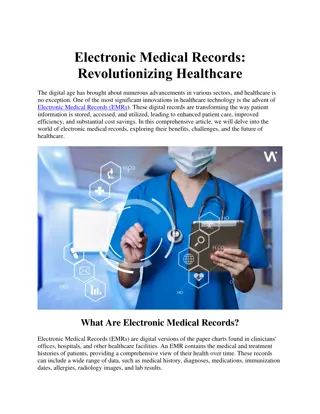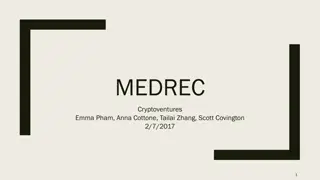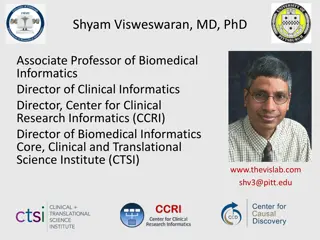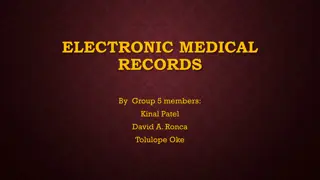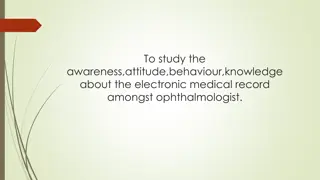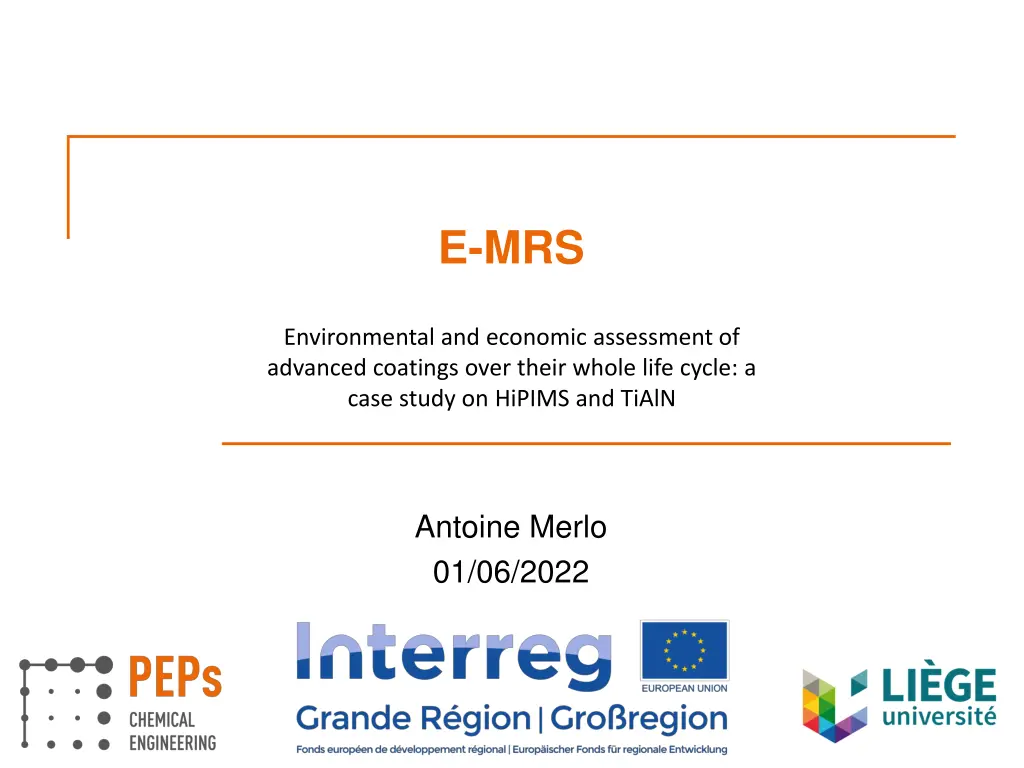
Environmental and Economic Assessment of HiPIMS and TiAlN Coatings
This case study evaluates advanced coatings utilizing High Power Impulse Magnetron Sputtering (HiPIMS) and Titanium Aluminum Nitride (TiAlN) over their entire life cycle. The study focuses on the environmental and economic impacts of these coatings, comparing their performance, costs, tool life, and productivity. It explores the benefits of HiPIMS coatings in terms of energy, density, coverage, and adhesion, despite their lower deposition rate. The assessment considers factors such as tool life, downtimes, productivity, and electricity consumption to provide a comprehensive evaluation of these coatings.
Download Presentation

Please find below an Image/Link to download the presentation.
The content on the website is provided AS IS for your information and personal use only. It may not be sold, licensed, or shared on other websites without obtaining consent from the author. If you encounter any issues during the download, it is possible that the publisher has removed the file from their server.
You are allowed to download the files provided on this website for personal or commercial use, subject to the condition that they are used lawfully. All files are the property of their respective owners.
The content on the website is provided AS IS for your information and personal use only. It may not be sold, licensed, or shared on other websites without obtaining consent from the author.
E N D
Presentation Transcript
E-MRS Environmental and economic assessment of advanced coatings over their whole life cycle: a case study on HiPIMS and TiAlN Antoine Merlo 01/06/2022 1
Introduction 1 Thin films are becoming more prevalent than ever and there is a need for environmental accountability! Applying assessment techniques to deposition processes Joint economic and environmental assessment 1Reve news : https://www.evwind.es/2020/07/05/in-2019-the-solar-pv- market-increased-an-estimated-12-to-around-115-gw/75561 2
PULSATEC project INTERREG Great-Region project (Li ge, NE France, West Germany, Luxembourg) Project based around HiPIMS High Powered Impulse Magnetron Sputtering! 3
HiPIMS Magnetron Sputtering: coating technology Vaccuum chamber Voltage to sputter target HiPIMS: High V pulses to increase ionization rate! 4
Characteristics of HiPIMS coatings High energy High density More ions Better coverage Better adhesion BUT lower deposition rate! 5
Goal HiPIMS: costlier, but better performing coatings than MS- DC Evaluate costs and impacts for both: Coating phase Cutting phase Higher tool life Lower downtimes Higher productivity and lower passive electricity consumption Joint evaluation of costs and environmental impacts 6
TiAlN and HiPIMS Higher performances of HiPIMS coatings Improved tool life Good enough to compensate higher HiPIMS costs? Weichart, J. (2012). Titanium aluminum nitride sputtered by HIPIMS , IOP Conference Series Materials Science and Engineering 7
Tools considered HSS milling tools: 8mm diameter, 8 cm length 4 m TiAlN Tool life of 75 min for HiPIMS and 50 min for MS-DC 1.8 m/h for HiPIMS 3.6 m/h for DC-MS 8
Installations 200 tools per batch Rotating and heating substrates HiPIMS :1 300 000 DC-MS :1 200 000 Same consumptions for both processes but longer deposition time for HiPIMS (133 min vs 67 min) 9
Cost evaluation of 1 coating Two 8h shifts per day (40 per operator) 1464 vs 1094 batches a year (MS-DC vs HiPIMS) 2.5 0.08 /kWh Cost per coating ( ) 2 1.5 5 year payback 1 0.5 0 HiPIMS DC Labor Consumables Annuities Maintenance 10
Environmental impact of 1 coating CO2 emissions: 320.7 gCO2 for HiPIMS, 191.2 gCO2 Electricity production is the main factor (Belgian EF: 174 gCO2/kWh 350 300 250 CO2 emissions (g) 200 150 100 50 0 HiPIMS DC Argon Nitrogen Target Electricity 11
Cutting phase Inclusion of costs and impacts of cutting phase: Substrate Coatings Cutting fluid Electricity consumed Tool life has an impact on those factors! 12
Cutting phase costs Longer tool life leads to lower down times Lower costs and higher productivity 40 35 Cost per machine piece ( ) 30 25 20 15 10 5 0 DC HiPIMS Operator Electricity Coating Tool Oil 13
Cutting phase impacts Higher CO2 emissions for HiPIMS coatings, but: Less substrates used Less cutting fluid Less passive electricity usage 800 CO2 emissions per machine piece (g) 700 600 500 400 300 200 100 0 DC HiPIMS Electricity Coating Tool Oil Oil disposal 14
Cutting phase evaluation conclusions Use of HiPIMS reduces the total cost by around 10% and CO2 emissions by 15% High potential for HiPIMS technology Different operating parameters ? Lubrification conditions Cutting speed Costa, Eder & Bacci Da Silva, Marcio & Machado, Alisson. (2009). Burr Produced on the Drilling Process as a Function of Tool Wear and Lubricant-Coolant Conditions. Journal of The Brazilian Society of Mechanical Sciences and Engineering - J BRAZ SOC MECH SCI ENG. 31. 10.1590/S1678-58782009000100009. 15
Parametrisation: Taylors equation Parametrisation of cost and CO2 (2 objectives) ??? = ? Use cutting speed as a parameter 16
Parametrisation: Taylors equation Until experimental data, assumed that tool lives and powers evolve with speed as in * 80 70 60 ? (2? ) ? (? ) ?(2?) ?(?)= Tool life (min) 50 40 30 20 10 0 17.4 34.8 Cutting speed (m/min) 52.2 69.6 87 HiPIMS DC *Li, C. (2015). A quantitative approach to analyze carbon emissions of CNC-based machining systems , Journal of Intelligent Manufacturing 26, pp. 911-922 17
Parametrisation Plot of CO2 emissions vs costs Several lubrication scenarios Cutting speed varies between 5 and 100 m/min 18
Parametrisation Plot of CO2 emissions vs costs Several lubrication scenarios Cutting speed varies between 5 and 100 m/min HiPIMS lowers both costs and CO2 impacts ! 19
Parametrisation Plot of CO2 emissions vs costs Several lubrication scenarios Cutting speed varies between 5 and 100 m/min Cutting speeds reduce costs, but increase CO2 emissions HiPIMS lowers both costs and CO2 impacts ! 20
Parametrisation conclusions HiPIMS in flood machining conditions seems to bring the best outcomes for both costs and CO2 emissions Trade-offs between CO2 emissions and costs How to choose the best cutting speed? Aggregation of CO2 emissions via a carbon tax 21
Carbon tax: 120/tCO2 30 25 20 Total cost ( ) 15 10 5 0 30 40 50 60 70 80 90 100 Cutting speed (m/min) Base cost Carbon tax 22
Carbon tax: 250/tCO2 30 25 20 Total cost ( ) 15 10 5 0 30 40 50 60 70 80 90 100 Cutting speed (m/min) Base cost Carbon tax 23
Carbon tax: 5000/tCO2 30 25 20 Total cost ( ) 15 10 5 0 30 40 50 60 70 80 90 100 Cutting speed (m/min) Base cost Carbon tax 24
TiAlN Conclusions CO2 emissions differences are negligible, even with aberrant carbon taxes HiPIMS in FM at high machining speeds seem to be the best option Need of experimental data to validate assumptions 25
Rfrences [1] IndustryArc (2021). Cutting Tools Market - Forecast(2021 - 2026) [2] Bobzin, K. (2016). High-performance coatings for cutting tools , CIRP Journal of Manufacturing Science and Technology [3] Jindal, P.C. et al. (1999). Performance of PVD TiN, TiCN, and TiAlN coated cemented carbide tools in turning , International Journal of Refractory Metals & Hard Materials, 17, pp. 163-170. [4] Kottfer, D. et al. (2013). Investigation of Ti and Cr based PVD coatings deposited onto HSS Co 5 twist drills , Applied Surface Science, 282, pp. 770-776. [5] M nz, V.-D. (1986), Titanium aluminum nitride films: A new alternative to TiN coatings , Journal of Vacuum Science & Technology A, 4(6) [6] Weichart, J. (2012). Titanium aluminum nitride sputtered by HIPIMS , IOP Conference Series Materials Science and Engineering [7] Anders, A. (2010). Deposition rates of high power impulse magnetron sputtering: Physics and economics , Journal of Vacuum Science & Technology A 28, p. 783 [8] Li, C. (2015). A quantitative approach to analyze carbon emissions of CNC-based machining systems , Journal of Intelligent Manufacturing 26, pp. 911-922 27


